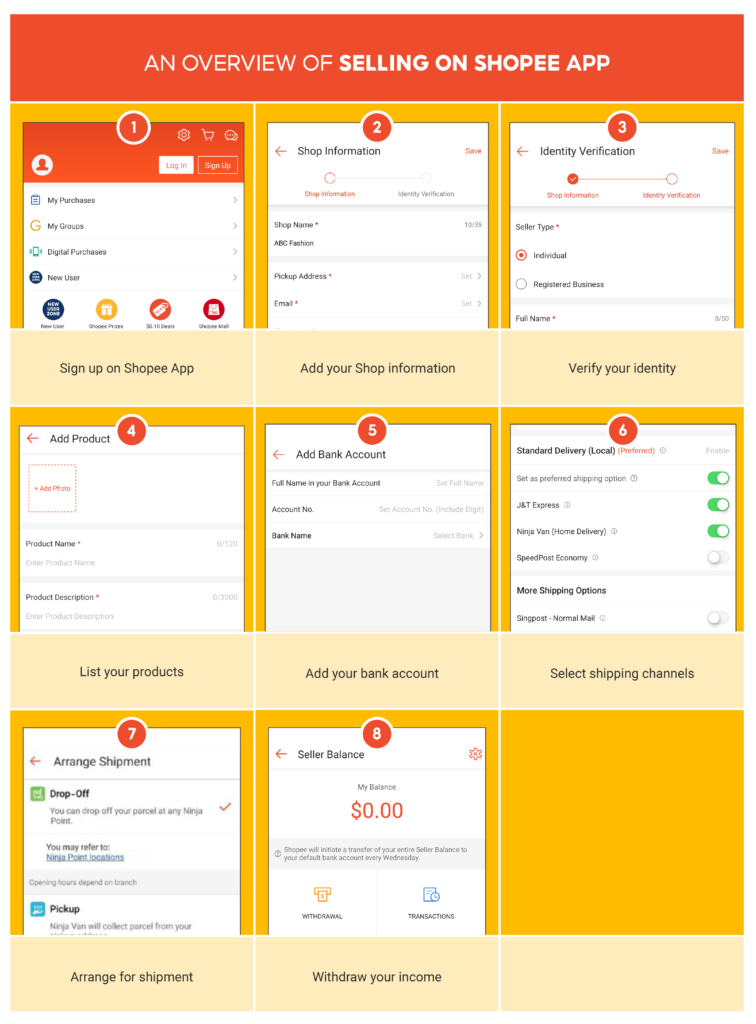Have you ever wondered how to sell on Shopee in the Philippines and tap into one of the fastest-growing e-commerce markets in Southeast Asia?
Well, you’re in the right place!
As someone who’s navigated the ins and outs of online selling, I’m here to share my insights and help you kickstart your Shopee journey.
Shopee has become a household name in the Philippines, with over 90 million monthly active users across Southeast Asia.
This mobile-first platform offers a unique opportunity for sellers to reach a vast customer base without the need for a physical store.
Whether you’re a budding entrepreneur or an established business looking to expand online, Shopee provides a user-friendly interface and a range of tools to help you succeed.
In this guide, we’ll walk through everything you need to know about selling on Shopee in the Philippines, from setting up your shop to optimizing your sales.
What You’ll Need to Start Selling on Shopee

Before we get into how to sell on Shopee in the Philippines, let’s make sure you have all the essentials in place.
Here’s what you’ll need to get started:
Basic Requirements:
- A smartphone or computer with internet access: Shopee is primarily a mobile platform, but you can also manage your shop via desktop.
- Valid identification: This is crucial for account verification and ensuring a secure selling environment.
- Products to sell: Ensure your items comply with Shopee’s policies and are not on their prohibited list.
- A bank account: This is necessary for receiving payments from your sales.
- High-quality product photos: Clear, attractive images can significantly boost your sales potential.
Optional but Helpful Tools:
- A digital camera or smartphone with a good camera: For taking high-quality product photos.
- Basic photo editing software: To enhance your product images and create eye-catching listings.
- Packaging materials: To ensure your products are shipped safely and professionally.
- A printer: For printing shipping labels and invoices.
Having these tools at your disposal will give you a head start in creating a professional and efficient Shopee shop.
Remember, selling on Shopee in the Philippines is all about presenting your products in the best light and providing excellent customer service.
With these basics covered, you’re ready to take the first steps towards becoming a successful Shopee seller.
Let’s move on to the step-by-step process of setting up your shop and listing your products.
Step-by-Step Instructions: How to Sell on Shopee in the Philippines

Now that you have everything you need, let’s walk through the process of setting up your Shopee shop in the Philippines.
Follow these steps carefully to ensure a smooth start to your selling journey.
Step 1: Create Your Shopee Account

- Download the Shopee app from the App Store or Google Play Store. Or go to https://shopee.ph/seller/signup
- Open the app and tap on the “Me” icon at the bottom right.
- Select “Sign Up” and choose to register with your phone number or email.
- Fill in the required information and verify your account.
Tip: Use a strong, unique password to protect your account.
Step 2: Set Up Your Shop Profile
- In the Shopee app, go to “Me” and tap on “My Shop”.
- Select “Setup Shop Now” and follow the prompts to create your shop.
- Choose a catchy shop name that reflects your brand.
- Upload a shop logo and banner image.
- Write a compelling shop description.
Important: Your shop name and description play a crucial role in SEO.
Include relevant keywords to help customers find your shop easily (Doan, 2024).
Step 3: Add Your Products
- In your shop, tap on the “+” icon to add a new product.
- Upload clear, high-quality photos of your product (up to 9 photos per listing).
- Write a detailed product description, including key features and specifications.
- Set your price and stock quantity.
- Choose the appropriate category and add relevant tags.
Pro Tip: Use Shopee’s “Boost Now” function to increase visibility for up to 5 products every 4 hours.
Read also:
Step 4: Configure Shipping and Payment Settings
- Go to “My Shop” > “Settings” > “Shipping”.
- Set up your pickup address for order fulfillment.
- Choose the shipping options you want to offer.
- In “Payment Settings”, link your bank account for receiving payments.
Note: Enabling Shopee’s free shipping option can make your products more attractive to buyers.
Step 5: Manage Orders and Customer Service
- Regularly check your “To-Ship” orders and process them promptly.
- Respond to customer inquiries within 12 hours to maintain a good chat response rate.
- Handle returns and refunds according to Shopee’s policies.
Remember: Excellent customer service is key to becoming a Shopee Preferred Seller.
If you follow these steps, you’ll have successfully set up your shop and be ready to start selling on Shopee in the Philippines.
The platform’s user-friendly interface makes it easy for beginners to get started, but don’t worry if you encounter any hiccups along the way.
We’ll cover troubleshooting and tips for success in the following sections.
Tips for Success Selling on Shopee in the Philippines
Now that you know how to sell on Shopee in the Philippines, let’s explore some strategies to help you stand out and boost your sales.
These tips are based on best practices and insights from successful Shopee sellers.
Optimize Your Product Listings
Use high-quality, clear images
- Showcase your products from multiple angles.
- Consider adding infographics or size charts for clarity.
Write compelling product descriptions
- Include key features, specifications, and benefits.
- Use bullet points for easy readability.
Price competitively
- Research similar products to ensure your pricing is attractive.
- Consider offering bundle deals or discounts for multiple purchases.
Leverage SEO techniques
- Use relevant keywords in your product titles and descriptions.
- Update your listings regularly to keep them fresh for Shopee’s algorithm.
Pro Tip: Shopee’s algorithm favors shops with complete and detailed product information (Doan, 2024).
Utilize Shopee’s Promotional Tools
Participate in Shopee campaigns
- Join Shopee’s Double Double Sales (11.11, 12.12) for increased visibility.
- Utilize Flash Sales to create urgency and boost conversions.
Use Shopee Ads
- Invest in Shopee’s advertising options to increase your product visibility.
- Experiment with different ad types: Product Search Ads, Discovery Ads, and Shop Ads.
Offer free shipping
- Set up a valid pickup address to qualify for Shopee’s free shipping program.
- Consider absorbing shipping costs to make your products more attractive.
Remember: On average, sellers using Shopee Ads experience a 24% increase in orders and a 26% boost in sales revenue.
Build a Positive Seller Reputation
Provide excellent customer service
- Respond to inquiries promptly (aim for a 12-hour response time).
- Be polite and professional in all customer interactions.
Ship orders quickly and accurately
- Process orders within the promised timeframe.
- Double-check orders before shipping to avoid mistakes.
Encourage positive reviews
- Follow up with customers after their purchase.
- Address negative feedback promptly and professionally.
Maintain consistent stock levels
- Keep your inventory updated to avoid cancellations.
- Use Shopee’s stock management tools to stay organized.
Pro Tip: Aim to become a Shopee Preferred Seller by maintaining high performance metrics and adhering to Shopee’s policies.
Implement these tips and you’ll be well on your way to success in selling on Shopee in the Philippines.
Remember, building a successful online business takes time and effort.
Stay patient, keep learning, and don’t be afraid to experiment with different strategies to find what works best for your shop.
Common Mistakes to Avoid
As you embark on your journey of selling on Shopee in the Philippines, it’s important to be aware of common pitfalls that can hinder your success.
You’ll save time, money, and frustration by avoiding these mistakes.
Let’s explore some of the most frequent errors new Shopee sellers make and how to steer clear of them.
1. Poor Product Descriptions and Images
One of the biggest mistakes sellers make is underestimating the power of product presentation.
Remember, your customers can’t physically touch or see your products, so your descriptions and images need to do the heavy lifting.
What to avoid:
- Vague or incomplete product descriptions
- Low-quality, blurry, or poorly lit photos
- Using stock images instead of actual product photos
How to fix it:
- Write detailed, accurate descriptions that highlight key features and benefits
- Invest in good lighting and a decent camera (even a smartphone camera can work wonders)
- Take multiple photos from different angles, including close-ups of important details
Pro Tip: According to Shopee’s guidelines, including your shop name and using terms like “online shop” in your descriptions can improve your visibility.
2. Inconsistent Customer Service
Customer service can make or break your business.
Poor communication and slow response times can lead to negative reviews and lost sales.
What to avoid:
- Ignoring customer inquiries or taking too long to respond
- Being unprofessional or dismissive in your communication
- Failing to address negative feedback
How to fix it:
- Aim to respond to all inquiries within 12 hours
- Use Shopee’s chat feature to keep all communication on the platform
- Address negative feedback promptly and professionally, offering solutions when possible
Remember: Your chat response rate is calculated based on your responses within 12 hours, and it’s updated twice a day.
3. Neglecting to Stay Updated on Shopee Policies
Shopee’s policies and features are constantly evolving.
Failing to keep up with these changes can lead to penalties or missed opportunities.
What to avoid:
- Violating Shopee’s prohibited items list
- Ignoring updates to shipping or return policies
- Missing out on new features or promotional opportunities
How to fix it:
- Regularly check Shopee’s seller resources and announcements
- Join Shopee seller forums or social media groups to stay informed
- Set aside time each month to review and update your shop policies
Pro Tip: Shopee often introduces new promotional tools and campaigns.
Staying informed can help you take advantage of these opportunities to boost your sales.
4. Overpricing or Underpricing Your Products
Finding the right price point is crucial when selling on Shopee in the Philippines.
Pricing too high can deter customers, while pricing too low can eat into your profits or make your products seem low-quality.
What to avoid:
- Setting prices without researching the market
- Failing to account for all your costs (including Shopee fees and shipping)
- Pricing inconsistently across your product range
How to fix it:
- Research your competitors’ pricing
- Calculate your costs carefully, including packaging, shipping, and Shopee fees
- Consider offering bundle deals or volume discounts to attract buyers
Remember: Shopee’s algorithm favors competitively priced items, so finding the right balance is key to visibility and sales.
Remember, every seller faces challenges, but it’s how you learn and adapt that sets you apart.
Keep these tips in mind as you navigate the exciting world of selling on Shopee in the Philippines.
Troubleshooting Common Issues
Even with the best preparation, you may encounter some challenges when selling on Shopee in the Philippines.
Don’t worry – most issues have straightforward solutions.
Let’s discuss some common problems and how to resolve them.
Dealing with Negative Feedback
Negative reviews can be disheartening, but they’re also an opportunity to showcase your customer service skills.
Problem: You’ve received a negative review that you feel is unfair or inaccurate.
Solution:
- Take a deep breath and respond calmly and professionally.
- Address the specific issues mentioned in the review.
- Offer a solution or compensation if appropriate.
- If the review violates Shopee’s guidelines, report it to Shopee support.
Pro Tip: Maintaining professionalism when handling negative reviews can actually improve your reputation and show potential customers that you care about their experience.
Resolving Shipping Problems
Shipping issues can lead to customer dissatisfaction and affect your seller metrics.
Problem: An order is marked as “shipped” but the customer hasn’t received it.
Solution:
- Double-check the shipping details to ensure they’re correct.
- Contact the logistics provider for an update on the package’s status.
- Keep the customer informed about the situation and any steps you’re taking.
- If the package is lost, initiate the claims process with the shipping company.
Remember: Shopee offers various shipping options.
Familiarize yourself with each to choose the best one for your products and customers.
Handling Payment Disputes
Payment issues can be frustrating for both sellers and buyers.
Problem: A customer claims they haven’t received the item and requests a refund, but your tracking shows it was delivered.
Solution:
- Gather all relevant information (order details, tracking number, delivery confirmation).
- Respond to the dispute through Shopee’s official channels.
- Provide clear evidence to support your case.
- If necessary, escalate the issue to Shopee’s customer support for mediation.
Pro Tip: Keep detailed records of all transactions and communications to help resolve disputes quickly and fairly.
Technical Issues with Your Shop
Sometimes, you might encounter technical glitches that affect your ability to manage your shop effectively.
Problem: You’re unable to update your product listings or process orders.
Solution:
- Check your internet connection and try accessing Shopee from a different device.
- Clear your browser cache or reinstall the Shopee app.
- If the problem persists, contact Shopee seller support for assistance.
- In the meantime, communicate with your customers about any delays.
Remember: Shopee regularly updates its platform.
Keep your app and browser up to date to avoid compatibility issues.
Managing Inventory Discrepancies
Keeping your inventory accurate is crucial for maintaining customer satisfaction and avoiding overselling.
Problem: Your Shopee inventory doesn’t match your actual stock.
Solution:
- Conduct a physical inventory count to identify discrepancies.
- Update your Shopee listings to reflect accurate stock levels.
- Implement a system to track sales across all your selling channels.
- Consider using inventory management software if you’re selling on multiple platforms.
Pro Tip: Regularly reconciling your inventory can prevent overselling and improve your overall shop performance.
Alternatives To Selling on Shopee in the Philippines
While we’ve covered the standard approach to selling on Shopee in the Philippines, there are several variations and alternatives that you might want to consider.
These options can help you expand your reach, increase your sales, or cater to specific business models.
Let’s look at some of these alternatives and when they might be appropriate for your business.
Becoming a Shopee Mall Seller
Shopee Mall is a curated space for official brand stores and authorized distributors.
It offers increased visibility and credibility to sellers.
When to consider:
- If you’re an established brand or authorized distributor
- When you can consistently maintain high customer service standards
- If you’re ready to commit to stricter policies and performance metrics
How to become a Shopee Mall Seller:
- Meet Shopee’s eligibility criteria (e.g., high seller ratings, quality listings)
- Apply through the Shopee Mall Seller Application Form
- Wait for Shopee’s assessment (usually 5-10 business days)
- If approved, maintain the required performance standards
Pro Tip: Shopee Mall sellers enjoy benefits like a special badge, prioritized visibility, and participation in exclusive campaigns.
Cross-Border Selling Opportunities
Shopee’s cross-border program allows sellers to reach customers in other Southeast Asian countries and Taiwan.
When to consider:
- If you have unique products with international appeal
- When you’re ready to handle international shipping and customer service
- If you want to tap into a larger market beyond the Philippines
How to start cross-border selling:
- Ensure your products comply with international shipping regulations
- Apply for Shopee’s cross-border selling program
- Set up international shipping options
- Prepare for multi-language customer support
Remember: Cross-border selling can be complex, so research thoroughly and start small to test the waters.
Utilizing Shopee’s Advertising Options
While organic reach is important, Shopee’s advertising tools can give your products an extra boost in visibility.
When to consider:
- If you’re in a competitive product category
- When you have new products you want to promote quickly
- If you have the budget to invest in paid advertising
Types of Shopee Ads:
- Product Search Ads: Display your products prominently in search results
- Discovery Ads: Showcase your products across various sections of Shopee
- Shop Ads: Feature your entire shop at the top of search results
Pro Tip: On average, sellers using Shopee Ads see a 24% increase in orders and a 26% boost in sales revenue for advertised products.
Leveraging Shopee Live
Shopee Live is a real-time video streaming feature that allows you to showcase your products and interact with customers directly.
When to consider:
- If your products benefit from demonstrations or detailed explanations
- When you want to build a more personal connection with your customers
- If you’re comfortable with live presentations and have a good camera setup
How to use Shopee Live:
- Plan your live stream content and prepare your products
- Set up your streaming equipment (smartphone or camera)
- Promote your upcoming live stream to your followers
- Engage with viewers during the stream and answer questions in real-time
Remember: Shopee Live can be an excellent way to build brand loyalty and increase sales through limited-time offers during the stream.
Participating in Shopee Affiliate Program
If you have a strong online presence outside of Shopee, you might consider becoming a Shopee affiliate.
When to consider:
- If you have a blog, YouTube channel, or social media following
- When you want to earn additional income by promoting Shopee products
- If you’re interested in content creation and marketing
How to become a Shopee affiliate:
- Apply to join the Shopee Affiliate Program
- Once approved, choose products to promote
- Create content featuring Shopee products with your unique affiliate link
- Earn commissions on sales made through your links
Pro Tip: The Shopee Affiliate Program can be a great way to monetize your online presence while helping your audience discover products they’ll love.
These variations and alternatives offer different ways to approach selling on Shopee in the Philippines.
Each has its own advantages and challenges, so consider your business goals, resources, and expertise when deciding which path to take.
Remember, you can always start with the standard selling approach and explore these alternatives as your Shopee business grows and evolves.
Shopee Pros and Cons
Shopee’s a household name in the Philippines, right?
It’s where you go for flash sales, free shipping, and that endless scroll of products.
But is it all sunshine and rainbows? Nope.
Let’s break it down, the good, the bad, and the ugly of Shopee, so you can decide if it’s still your go-to shopping app.
The Good: Why We Love Shopee
- Bargain Hunter’s Paradise: Flash sales, discount vouchers, free shipping… Shopee’s got it all. If you’re on a budget, you’re bound to find a good deal here.
- Endless Variety: Clothes, gadgets, home decor, even groceries – Shopee’s got it all. You can literally spend hours browsing and still not see everything.
- Convenient & Easy to Use: The app is user-friendly, and the checkout process is a breeze. Plus, you can track your orders every step of the way.
- ShopeePay Perks: Using ShopeePay often comes with extra discounts and cashback. It’s a win-win.
The Bad: Where Shopee Falls Short
- Quality Control Issues: Let’s be honest, not all sellers on Shopee are created equal. You might end up with a product that’s not quite as advertised.
- Shipping Delays: While Shopee offers free shipping, it can sometimes take a while for your package to arrive. Patience is key.
- Customer Service Challenges: Getting a response from customer service can be frustrating at times. It’s not always the smoothest experience.
- Addictive Nature: The constant sales and notifications can lead to impulse purchases. It’s easy to get carried away.
The Ugly: Things Shopee Needs to Fix
- Fake Products: Counterfeit items are a real problem on Shopee. Always do your research before buying from a new seller.
- Scams & Fraud: Unfortunately, there have been cases of scams and fraudulent activity on the platform. Be cautious and vigilant.
- Overwhelming Interface: With so many products and promotions, the app can feel cluttered and overwhelming at times.
- Environmental Impact: The constant packaging and shipping can take a toll on the environment. It’s something to consider.
Is Shopee Still Worth It?
Shopee’s got its pros and cons, no doubt.
But for many Filipinos, the convenience and affordability outweigh the negatives.
If you’re a savvy shopper who knows how to navigate the platform, Shopee can still be a great place to find deals and discover new products.
Just remember to be smart, do your research, and don’t get carried away by the flash sales!
After all, a good deal isn’t so good if it ends up being a waste of money.
So, what do you think?
Is Shopee still your go-to shopping app?
Or are you ready to explore some alternatives?
Shopee Alternatives: 5 Hidden Gems You Need to Know About
Ever felt like you’ve explored every nook and cranny of Shopee?
You’re not alone.
Millions of Filipinos flock to Shopee for their online shopping needs, but sometimes, it’s good to shake things up.
You might find even better deals, unique products, or a more personalized shopping experience elsewhere.
So, if you’re ready to break free from the Shopee routine, let’s dive into 5 of the best alternatives out there.
1. Lazada
Lazada is the heavyweight champion in the Philippine e-commerce ring, going toe-to-toe with Shopee.
It’s your go-to for almost anything you can imagine.
From electronics and appliances to fashion and beauty products, Lazada has it all.
They also have frequent sales and promos, so keep an eye out for those!
- Pros: Massive selection, competitive prices, reliable delivery
- Cons: Can be overwhelming due to its size, customer service can be hit or miss
Read also: How to Sell on Lazada in the Philippines
2. Carousell
If you’re a fan of secondhand treasures and sustainable shopping, Carousell is your haven.
It’s a bustling marketplace where you can find everything from vintage clothing and furniture to pre-loved gadgets and books.
Haggling is encouraged, so sharpen your bargaining skills!
- Pros: Unique finds, eco-friendly, potential for great deals
- Cons: Requires more effort to find what you’re looking for, condition of items can vary
3. Zalora: The Fashionista’s Favorite
For the fashion-forward folks, Zalora is the place to be.
They curate a collection of trendy clothes, shoes, and accessories from both local and international brands.
If you’re looking to elevate your style game, Zalora is your one-stop shop.
- Pros: Curated selection, focus on fashion, easy returns
- Cons: Can be pricier than other options, limited variety outside of fashion
4. BeautyMNL
BeautyMNL is a treasure trove of skincare, makeup, and haircare products.
They offer a wide range of brands, from drugstore favorites to high-end luxury.
Plus, they have a helpful blog and community section where you can get tips and recommendations.
- Pros: Extensive beauty selection, informative content, frequent sales
- Cons: Limited to beauty products, delivery can be slower than other platforms
5. Facebook Marketplace
Don’t underestimate the power of Facebook Marketplace!
It’s a fantastic platform for finding locally sourced goods and supporting small businesses.
You can find anything from handmade crafts to fresh produce to secondhand furniture.
It’s all about connecting with your community.
- Pros: Local focus, supports small businesses, potential for unique finds
- Cons: Can be less organized than other platforms, requires more communication with sellers
Shopee is great, but don’t limit yourself!
There are plenty of other fantastic online shopping platforms in the Philippines waiting to be explored.
Whether you’re hunting for bargains, unique finds, or a more personalized experience, these alternatives have got you covered.
Final Thoughts
As we wrap up this comprehensive guide on how to sell on Shopee in the Philippines, let’s recap the key points and look towards your future as a successful Shopee seller.
Starting your Shopee journey is an exciting venture that offers immense potential for growth and success.
We’ve covered everything from setting up your shop and optimizing your listings to troubleshooting common issues and exploring alternative selling strategies.
Here are the main takeaways:
- Set up your shop professionally: Create a compelling shop profile, use high-quality images, and write detailed product descriptions.
- Optimize for visibility: Utilize SEO techniques, participate in Shopee campaigns, and consider using Shopee Ads to boost your visibility.
- Provide excellent customer service: Respond promptly to inquiries, handle orders efficiently, and address feedback professionally.
- Stay informed and adapt: Keep up with Shopee’s policies and new features, and be willing to adjust your strategies as needed.
- Explore additional opportunities: Consider options like becoming a Shopee Mall seller, cross-border selling, or using Shopee Live to expand your business.
Remember, success on Shopee doesn’t happen overnight. It requires patience, persistence, and a willingness to learn and adapt. Every sale, every customer interaction, and even every challenge is an opportunity to grow and improve your business.
As you embark on your Shopee selling journey, keep in mind that the e-commerce landscape in the Philippines is rapidly evolving.
Shopee’s user base continues to grow, with over 90 million monthly active users across Southeast Asia.
This presents an incredible opportunity for sellers like you to reach a vast and engaged audience.
Don’t be afraid to start small and scale up as you gain experience and confidence.
Utilize the tools and resources Shopee provides, stay customer-focused, and always strive to offer value through your products and service.
Whether you’re looking to turn your passion into a side hustle or build a full-fledged e-commerce empire, Shopee provides the platform and tools you need to succeed.
With dedication, creativity, and the knowledge you’ve gained from this guide, you’re well-equipped to thrive in the exciting world of selling on Shopee in the Philippines.
So, what are you waiting for?
It’s time to take that first step, set up your Shopee shop, and start your journey towards e-commerce success.
Remember, every successful Shopee seller started right where you are now. Your next big sale could be just around the corner!
Read also:
- 7 Best Courier Services for Online Sellers in the Philippines
- How to Ship Products Internationally from the Philippines
FAQ Section
To wrap up our comprehensive guide on how to sell on Shopee in the Philippines, let’s address some frequently asked questions that potential sellers often have:
Q: Is it free to start selling on Shopee?
A: Yes, it’s free to create a Shopee account and list your products. However, Shopee does charge transaction fees and commission on sales, which vary depending on your seller type and product category.
Q: How long does it take to set up a Shopee shop?
A: The basic setup can be done in a few hours. However, creating optimized listings and a professional shop profile may take a few days to perfect.
Q: What are the best-selling categories on Shopee Philippines?
A: According to research, popular categories include Fashion, Beauty, Home and Living, Electronics, and Toys and Hobbies.
Q: How does Shopee handle payments?
A: Shopee uses an escrow system. When a buyer makes a purchase, the payment is held by Shopee until the buyer confirms receipt of the item. Then, the funds are released to the seller.
Q: Can I sell internationally on Shopee?
A: Yes, Shopee offers cross-border selling opportunities. However, you’ll need to apply for their cross-border program and ensure you can handle international shipping and customer service.
Q: How can I improve my shop’s visibility on Shopee?
A: Optimize your listings with relevant keywords, participate in Shopee campaigns, maintain good seller metrics, and consider using Shopee Ads to boost visibility.
Q: What should I do if a customer leaves a negative review?
A: Respond professionally, address the specific issues mentioned, and offer a solution if possible. Use it as an opportunity to showcase your customer service skills.
Q: How often does Shopee pay sellers?
A: Shopee typically processes payments to sellers on a weekly basis, but this can vary depending on your seller status and bank processing times.
Q: Can I sell both new and used items on Shopee?
A: Yes, Shopee allows the sale of both new and used items, as long as they comply with Shopee’s policies and are accurately described in your listings.
Q: Is there a limit to how many products I can list on Shopee?
A: There’s no strict limit, but new sellers may have initial restrictions that increase over time as they build a positive selling history.
Remember, selling on Shopee in the Philippines is an ongoing learning process. Don’t hesitate to explore Shopee’s seller resources and community forums for more detailed information as you grow your business.
 Web HostingCost-effective shared hosting solutions
Web HostingCost-effective shared hosting solutions Reseller HostingStart your own hosting business without tech hustle
Reseller HostingStart your own hosting business without tech hustle Affiliate ProgramEarn commission by referring customers to our platforms
Affiliate ProgramEarn commission by referring customers to our platforms cPanel HostingHosting powered by cPanel (Mostly user friendly)
cPanel HostingHosting powered by cPanel (Mostly user friendly) Windows HostingOptimized for windows based-applications and sites
Windows HostingOptimized for windows based-applications and sites Domain SearchFind and register available domain names in seconds
Domain SearchFind and register available domain names in seconds All DomainsExplore and register domain extensions across the world
All DomainsExplore and register domain extensions across the world Domain Transfermove your domain to us with zero downtime and full control
Domain Transfermove your domain to us with zero downtime and full control Whois LookupLook up domain ownership, expiry dates and registrar information
Whois LookupLook up domain ownership, expiry dates and registrar information .com DomainSecure the most recognized domain for global credibility
.com DomainSecure the most recognized domain for global credibility VPS HostingScalable virtual servers. Full root access. Faster speed.
VPS HostingScalable virtual servers. Full root access. Faster speed. Managed VPSNot a tech expert? Choose our fully managed VPS server.
Managed VPSNot a tech expert? Choose our fully managed VPS server. Dedicated ServersGet the full power and complete control of your own physical server.
Dedicated ServersGet the full power and complete control of your own physical server.
